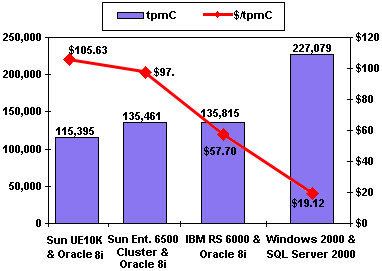The Transaction Processing Performance Council (TPC) , a nonprofit
organization, was founded for the purpose of defining transaction
processing and database performance benchmarks (such as TPC-C and TPC-H), and to
disseminate objective performance data based on those benchmarks. TPC benchmarks
have extremely stringent requirements, including both reliability and durability
tests, and must undergo an independent audit. Council members include most major
database vendors and suppliers of server hardware systems.
, a nonprofit
organization, was founded for the purpose of defining transaction
processing and database performance benchmarks (such as TPC-C and TPC-H), and to
disseminate objective performance data based on those benchmarks. TPC benchmarks
have extremely stringent requirements, including both reliability and durability
tests, and must undergo an independent audit. Council members include most major
database vendors and suppliers of server hardware systems.
Companies participate in TPC benchmarking to demonstrate objectively the performance of their
systems in a regulated environment, and to apply technologies used in the
testing process to produce more robust and scalable software and hardware
products.
TPC-C: Online Transaction Processing
TPC-C is the industry-standard benchmark for measuring the performance and scalability of
Online Transaction Processing (OLTP) systems. It tests a broad cross-section of
database functionality including inquiry, update, and queued mini-batch transactions.
Many information technology (IT) professionals consider TPC-C to be a valid
indicator of "real world" OLTP system performance.
is the industry-standard benchmark for measuring the performance and scalability of
Online Transaction Processing (OLTP) systems. It tests a broad cross-section of
database functionality including inquiry, update, and queued mini-batch transactions.
Many information technology (IT) professionals consider TPC-C to be a valid
indicator of "real world" OLTP system performance.
The TPC-C benchmark measures throughput in business
transactions per minute for a simulated order entry and distribution
environment. Specifically, it measures how many new order transactions per minute a system
generates while the system is simultaneously executing four other transaction
types (payments, order status updates, deliveries, and stock-level
changes). Independent auditors certify benchmark results and file a full disclosure report with
the TPC, which then posts the report on its Web site.
The Windows NT® Server 4.0 operating system figures
prominently in a number of the most recent TPC-C results. Windows NT Server
4.0-based solutions hold the top 40
spots in the TPC-C price/performance results. Furthermore, in terms of overall
performance, Windows NT Server 4.0-based solutions figure among the top ten
TPC-C results. On February 17, 2000 Microsoft announced that Windows® 2000 Server
running Microsoft SQL ServerTM 2000 on Compaq ProLiant 8500 systems provides record breaking TPC-C performance and scalability (see
Figure 1 below). This means that customers not only get the best
price per transaction with Windows 2000 Server, but can also be assured that
Windows 2000 Server and Compaq ProLiant scale to meet the most demanding database environments.

Figure 1. Audited performance results published using
the industry standard TPC-C database benchmark demonstrate that Windows 2000
Advanced Server running SQL Server 2000 on Compaq ProLiant systems provides about 70 percent better
database performance at a fraction of the cost compared to the leading UNIX
solutions from Sun and IBM. (The scale on the left represents the business
throughput of these systems, which is defined by the number of transactions
executed per minute as measured by the tpmC performance metric.)
TPC-H: Decision Support
TPC-H simulates a decision support system with large
volumes of data, synchronized with online production databases. It uses highly
complex, ad hoc queries
designed to answer real-world business questions such as pricing and promotions, supply and demand, profit and revenue, and market share. The
performance of standardized report generation is illustrated by a different benchmark,
TPC-R. TPC-H and TPC-R evolved out of the now retired
TPC-D benchmark. (Check back here later for updated results on Windows 2000
Server.)
simulates a decision support system with large
volumes of data, synchronized with online production databases. It uses highly
complex, ad hoc queries
designed to answer real-world business questions such as pricing and promotions, supply and demand, profit and revenue, and market share. The
performance of standardized report generation is illustrated by a different benchmark,
TPC-R. TPC-H and TPC-R evolved out of the now retired
TPC-D benchmark. (Check back here later for updated results on Windows 2000
Server.)


